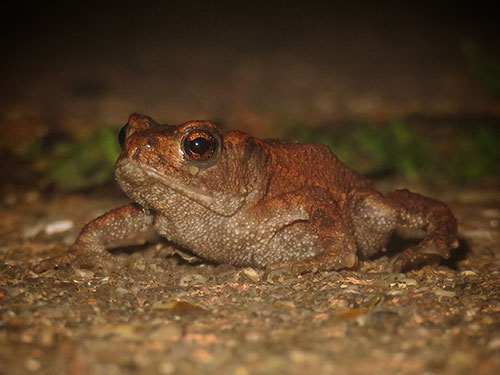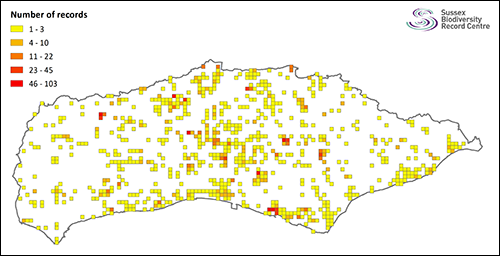


Common Toad Bufo bufo at Knepp
Photo: Ryan Greaves

Heat map of Common Toad records in Sussex, the red squares show where most records have been collected.
The Common Toad (Bufo bufo) is a solitary creature, spending the majority of its life on land buried in leaf litter, under tree roots, in log piles and in vegetable patches. Basically anywhere slightly damp where there is an abundance of invertebrate prey. However like all our native amphibians, Common Toad must return to water in spring to breed, sometimes travelling over 2km to get to their preferred pond.
Common Toad has dry warty skin and brilliant golden-bronze eyes with dark horizontal pupils. They are generally described as brown to olive brown, but colour can widely vary with some very dark or very red individuals. Additionally, a key identification feature are the large paratoid glands that stick up behind the eyes. These glands produce bufotoxin, an alkaloid neurotoxin that helps to defend against predation.
Common Toad have much shorter legs than Common Frog and tend to crawl or hop, rather than make large jumps. They also differ in their choice of breeding pond, generally preferring much deeper, larger bodies of water compared to the shallow pools where frogspawn can often be found. Common Toad-spawn is also very distinctive, being formed of long strings of a double row of eggs draped around submerged vegetation like a pearl necklace.
At this time of year Common Toad may be seen migrating back to their ancestral breeding pond, often disregarding any barriers that have appeared, including busy roads and deep drains. They tend to travel at dusk, most commonly emerging from their overwintering site after a spell of damp, warmish weather (air temp of 7-8°C). Unfortunately this can often coincide with peak car commuting times and scores of Common Toad can be killed as they try to cross roads.
Whilst, Common Toad is widespread in Britain, populations have declined dramatically over the last century and it is now listed as a Priority Species of Conservation Concern. Declines are largely due to habitat fragmentation and a huge loss of breeding ponds. However, the species is also generally under-recorded, so any sighting, especially of migrating or breeding Common Toad, is desirable. The map above shows where Common Toads have been recorded but also highlights the large areas of Sussex from which we do not have any records.
Please report any sightings of Common Toads either to iRecord, or by email to bobforeman@sussexwt.org.uk with details of location, grid reference and date found.
Every month it is our aim to highlight a species that is “in-season” and, although not necessarily rare or difficult to identify, has been highlighted by our local recording groups as being somewhat under-recorded and for which new records would therefore be welcomed.
If you or your recording group are aware of species such as this then please contact Bob Foreman.